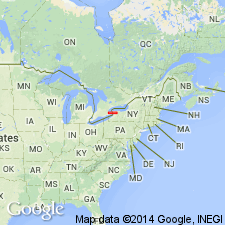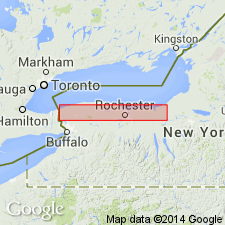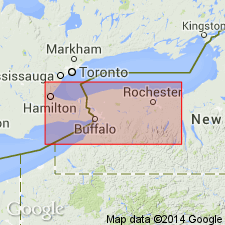
- Usage in publication:
-
- Hickory Corners Limestone Member
- Modifications:
-
- Named
- Dominant lithology:
-
- Limestone
- AAPG geologic province:
-
- Appalachian basin
Summary:
Named the Hickory Corners Limestone Member of the Reynales Limestone for Hickory Corners, Niagara Co., western NY. Consists of coarse to medium crystalline, argillaceous, highly siliceous, fossiliferous limestone. Thickness is 9 feet at type locality and 4.25 feet at Niagara Gorge. At type locality overlies Neahga Shale and underlies Rockway Dolomite Member of Irondequoit Formation; in Lockport area where both Neahga Shale and Thorold Sandstone are absent the Hickory Corners is in direct contact with Grimsby Sandstone. Beds equivalent to Hickory Corners have been recognized as far east as Genesee Gorge, but it is believed best to use names already in use in Genesee area when referring to this part of Reynales. In Rochester area, Hickory Corners equivalent consists of the Brewer Dock, Furnaceville, and lower part of Wallington Members. The Hickory Corners is of Silurian age.
Source: GNU records (USGS DDS-6; Reston GNULEX).

- Usage in publication:
-
- Hickory Corners Member
- Modifications:
-
- Overview
- AAPG geologic province:
-
- Appalachian basin
Summary:
Reynales Limestone at its type section is equivalent to the Hickory Corners Member, a term that is probably unnecessary because it is only the western extension of both the Brewer Dock Member and the lower beds of the Wallington Member. Includes Budd Road Bed (new) at the base.
Source: GNU records (USGS DDS-6; Reston GNULEX).

- Usage in publication:
-
- Hickory Corners Member*
- Modifications:
-
- Overview
- AAPG geologic province:
-
- Appalachian basin
Summary:
The Hickory Corners Member of the Reynales Limestone in western NY consists of thin- to medium-bedded, gray to pink, nodular, locally fossiliferous, dolomitic limestone with thin shale partings; chert is common near top. A phosphate horizon, the Budd Road Phosphate Bed, forms the base of the member. Characteristic fossils include brachiopods, crinoid columnals, and bryozoa. The Hickory Corners is the only part of the Reynales Limestone occurring in the Niagara region of NY. Thickness is 0 to 12 ft. Well exposed along railroad tracks south of intersection with Niagara Road immediately west of Lockport, NY, and in Niagara River Gorge south of Artpark, Lewiston, NY. Unconformably overlies the Neahga Shale and unconformably underlies the Merritton Limestone, or where the Merritton is absent, the Second Creek Phosphate Bed of the Williamson Shale. The Hickory Corners is of Early Silurian (Llandoverian) age. [Report uses Early and Late Silurian time scale of Harland and others (1982).]
Source: GNU records (USGS DDS-6; Reston GNULEX).
For more information, please contact Nancy Stamm, Geologic Names Committee Secretary.
Asterisk (*) indicates published by U.S. Geological Survey authors.
"No current usage" (†) implies that a name has been abandoned or has fallen into disuse. Former usage and, if known, replacement name given in parentheses ( ).
Slash (/) indicates name conflicts with nomenclatural guidelines (CSN, 1933; ACSN, 1961, 1970; NACSN, 1983, 2005, 2021). May be explained within brackets ([ ]).

